This article has been contributed by Jesper Faurby.
Imagine this. It’s early morning Monday, and already the week’s off to a rough start.
One of your graphic designers sent you an email over the weekend with an updated logo for a client. You’re supposed to present it in a few minutes but it’s buried in your inbox and you can’t find it.
Meanwhile, your content writer is trying to wrap up a blog post for another client, it’s supposed to go live in an hour. The corresponding photos and graphics are on Jane’s computer, however, and she had to take a personal day to deal with a family emergency.
On top of that, the intern just sent you a message, she’s feeling under the weather and doesn’t want to spread any bad germs. If you email her the presentation pack for your client meeting tomorrow, she’s happy to work on it from home. That’s great, but you’re still waiting for input from the web-dev team and your ad campaign manager. Each department is working on their own sections and the needed files are who knows where.
If you’ve worked in marketing, you’ve probably found yourself in a situation like this at one point or another. Trying to manage marketing projects often feels like herding cats. Everyone’s going in their own direction, messages are flying across various platforms (email, Slack, text, etc.), and there’s often multiple versions of any given graphic, logo, or document floating around on different pieces of hardware.
Instead of spending time working with clients or adding value elsewhere, you’re wasting precious minutes hunting for the right files. As your business and client list grows, the hassles only seem to multiply. And as remote work becomes the norm, coordinating teams and keeping digital assets in order is likely to become even more difficult.
These days, marketers need the right digital tools to keep projects on track and clients happy. Besides ubiquitous email and chat platforms, many marketers will benefit by setting up a digital asset management solution.
What Is A Digital Asset Management System?
Digital asset management (DAM) systems enable you to store key assets online, including graphics, documents, presentations, and more. Then you can control and provide access to these files not just to your team, but also to clients, contractors, and other stakeholders.
A DAM solution will include a file organization system. This system may look like the folders on your desktop or may feature another user interface. The files in a DAM system are uploaded to the web and you can typically share files with other users. This way, you don’t have to send files via email, hardcopy, through chat programs, or anything like that. Users can simply log into the DAM file system and find the assets they need.
There’s a good chance that you’ve already used a DAM system. Have you ever used Dropbox or Google Drive? Although they are arguably designed more for consumers and basic use, both are examples of DAM systems.
With the right DAM system, you can ensure that your digital assets are organized, accessible, and secure. You’ll be better positioned to impress clients with white label branding and professional presentation. And as you spend less time chasing down files, and more time adding value, you can increase your own brand strength and support your bottom line.
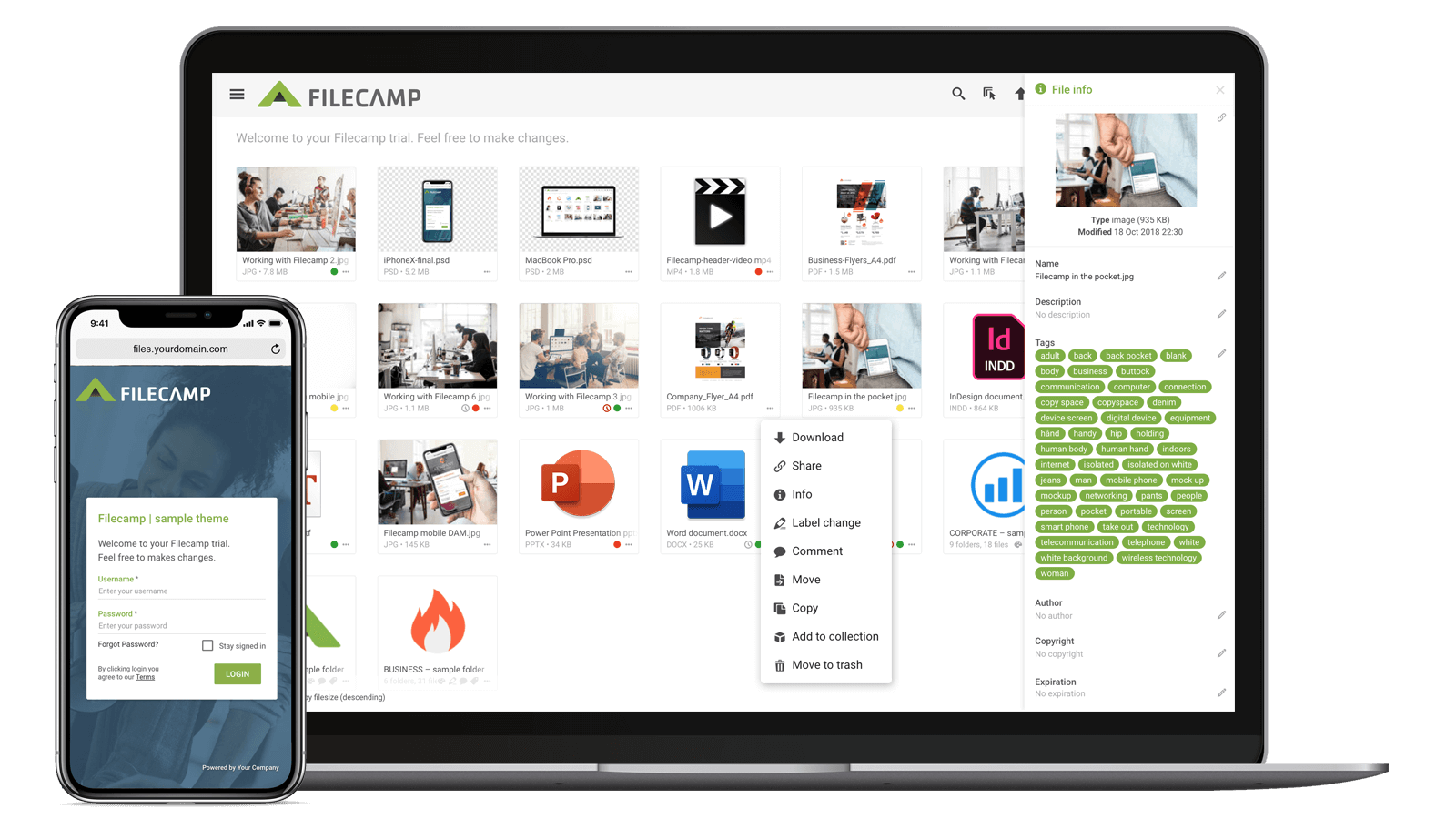
Individual DAM systems may look different but all strive to help businesses to manage and share your digital assets and other media files.
Why Do Marketers Need a DAM System?
In terms of marketing-specific digital asset management systems, there are a variety of solutions. Some have been around for decades, while others have been around for just a few years. Marketing-oriented DAMs are designed from the basic code up with the needs of marketing freelancers, professionals, and agencies in mind.
For some years now, many big marketing agencies have recognized just how much value DAM systems offer and have been paying big bucks for them. Some of the oldest and most established marketing DAM solutions cost thousands of dollars a month. Given that their customers continue to pay, these DAM companies justify their costs.
Still, expensive DAM solutions are out of reach for many freelancers and smaller companies. Thus, more affordable DAM solutions have entered the market, allowing small teams and freelancers to set up their own powerful, secure solutions.
Ultimately, the right DAM system will essentially pay for itself by increasing efficiency, making communication easier, and helping teams stay on track. At their core, DAM solutions are productivity tools, and for busy marketing professionals – from CMOs at Fortune 500 companies to freelancers – time often equates to results.
An Essential Productivity Tool
Look up “busy” in the dictionary and you might find a picture of a stressed-out marketing guru slumped over his or her desk. Marketing professionals have deliverables to work on and the client or boss wanted them delivered yesterday. You need to manage communications, fielding who knows how many messages a day. There are meetings to attend, skills to learn, and so much more.
Various digital tools will help you stay on track. For example, simple to-do lists help ensure that you’re aware of projects and approaching deadlines. Some software programs, like Trello, help you manage on-going projects and their progress from start to finish. These tools help you save time, reduce bottlenecks, and stay on top of all of your projects.
A DAM system is another powerful tool. It allows freelancers, teams, and companies to safely and securely store digital assets, including photographs, documents, vector files, and more. This means you’ll waste less time organizing, securing, and sharing those assets.
With a DAM solution, you’ll always know where your files are. Need to find a logo for a client? In a well-organized DAM system, you’ll know right where it is or can at least find it quickly. No more digging through emails or slogging through chat logs. Want to repurpose a print ad you used for an old client? Again, with a DAM it may be just a few clicks away.
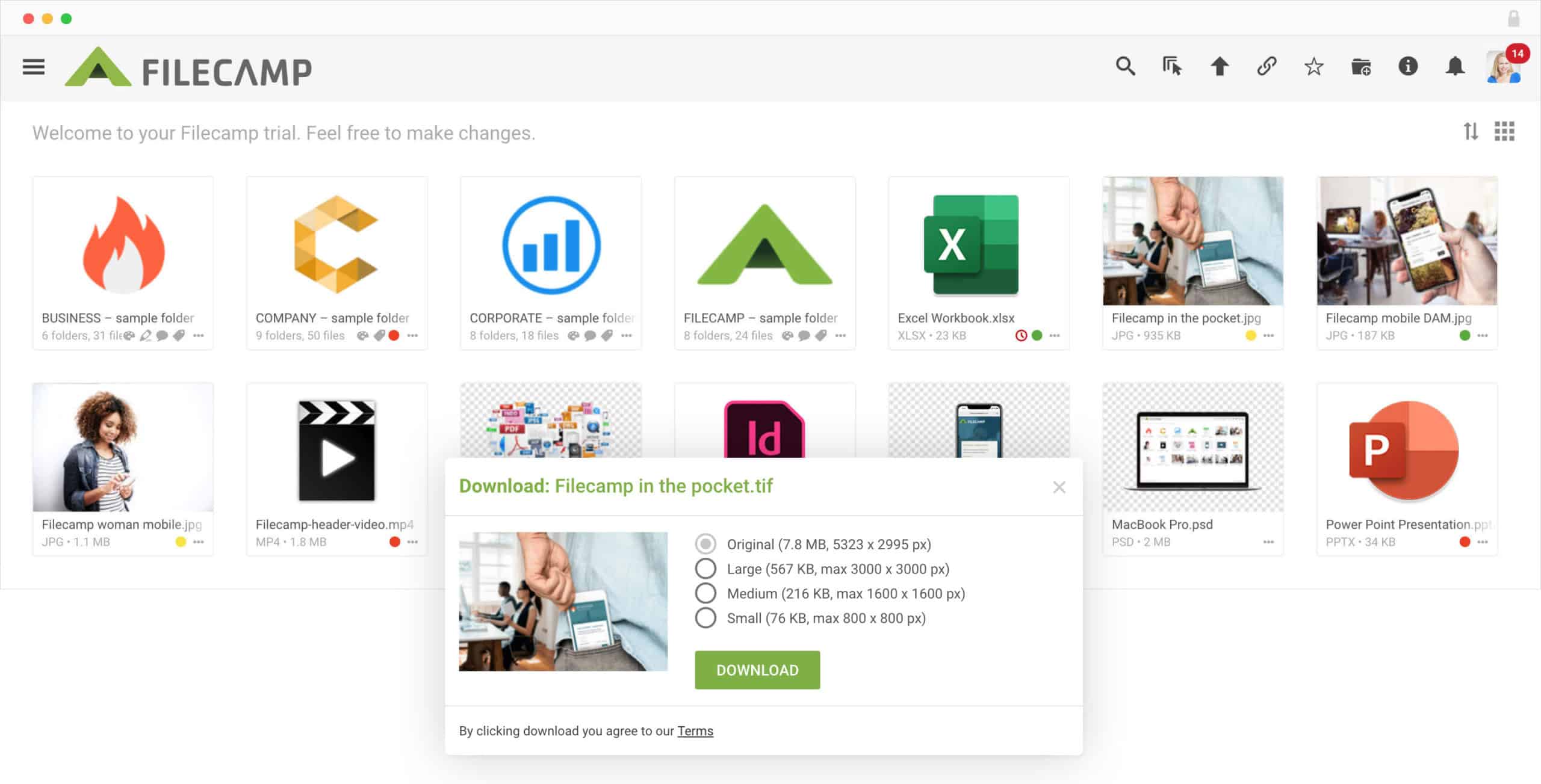
With a DAM tool, your clients can log in and download files in the right format and size.
Vital for Teamwork
DAM systems aren’t just for you either. They’re for the whole team, including external stakeholders, and they help everyone stay on track and perform at their best.
Take all the individual challenges a single marketing professional might face in a given day, then build that out to a team. Next, add in communication issues, version control, and juggling multiple projects at once, and it’s hard not to admire just how much effort marketing pros put in on any given day. Fortunately, the right DAM solution brings order to anarchy.

For one, stakeholders abound. Marketing is one of those functions that impacts the company as a whole, so feedback from product development, sales teams, logistics, the C-Suite, and more is common. Even if you’re a boutique marketing agency or freelancer working with small businesses, you may quickly find yourself interfacing with a lot of stakeholders. Everyone and their cousin may want to provide input and review materials.
Marketing projects often require diverse skills. On any given project, you might have to engage with video production managers, web design, packaging specialists, graphic designers, content writers, upper management, print shops, and your kid who’s learning graphic design at university, among others.
At first glance, a DAM system may seem like a simple file organizing platform, but it will also make communication easier.
Improves Team Communication
A DAM system offers a powerful but unobtrusive tool for coordinating teams and projects. DAM solutions don’t replace other popular communication tools like Slack and email, but they can supplement them. With Filecamp or a similar DAM program, your team members and clients can access files from pretty much anywhere in the world.
You can use digital asset management systems to store your most important files. Let’s say you’re launching a new website for a major company. Your London-based web designer can pull logos and other assets from your DAM system, ensuring brand consistency.
Meanwhile, your content specialist, who’s currently on a “workcation” in Italy, can quickly access your client’s brand style sheet. If anyone needs to drop you a message on Slack or send an email, they can still do so. Yet they don’t have to hunt through chat logs looking for the right file, they’re already uploaded to your DAM.
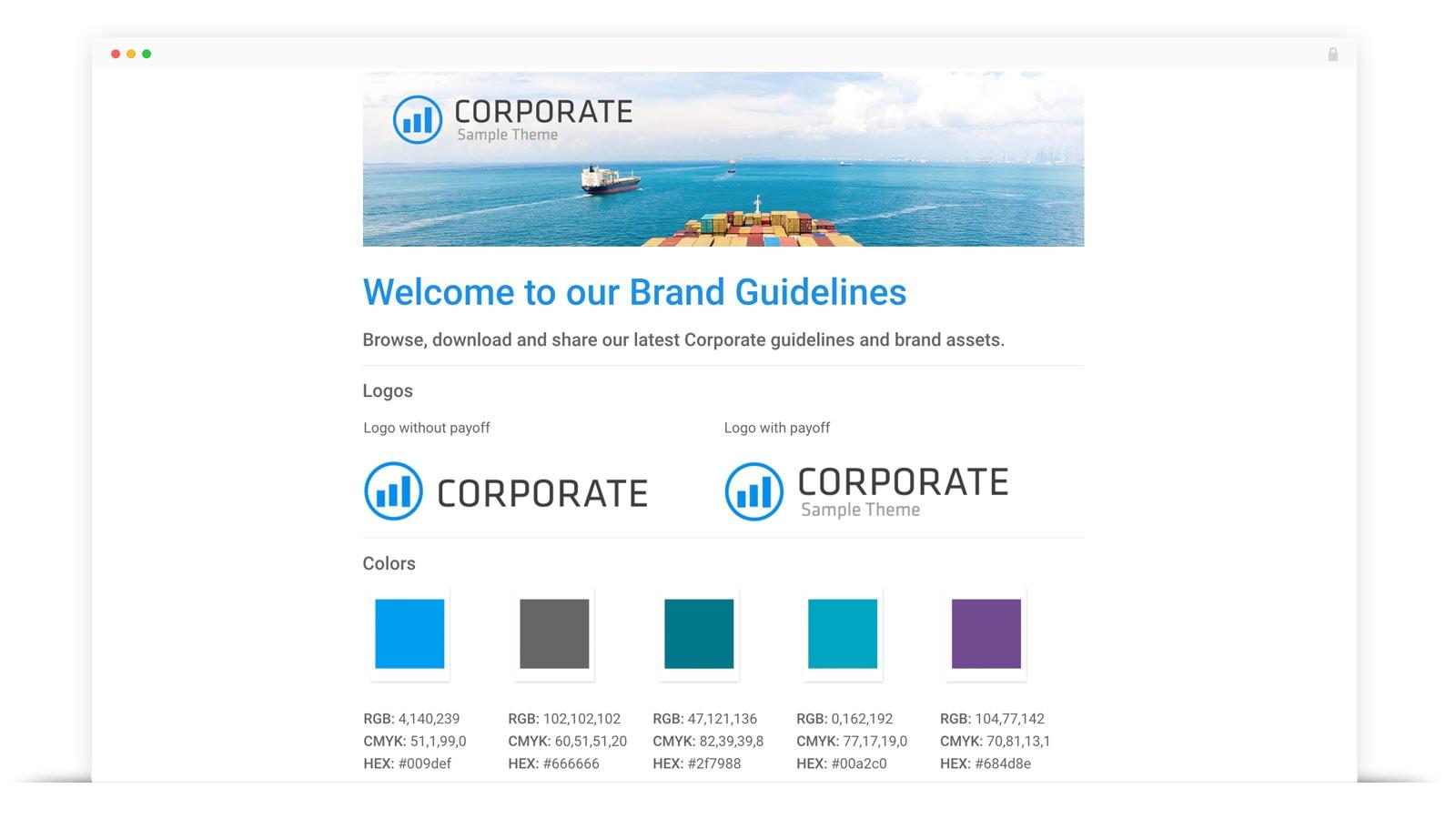
An updated and online brand style sheet can help you obtain brand consistency, and with some DAM solutions you can even create multiple brand guidelines for your clients as well.
Some DAM solutions feature easy commenting tools so people can add comments to documents. You might “approve” a logo revision, or leave a note asking your designer to change the background color, for example. Since the comments are attached to the appropriate digital asset, the message won’t get lost in a long chat log or overflowing inbox.
Online Proofing and Version Control Enhances Team Progress
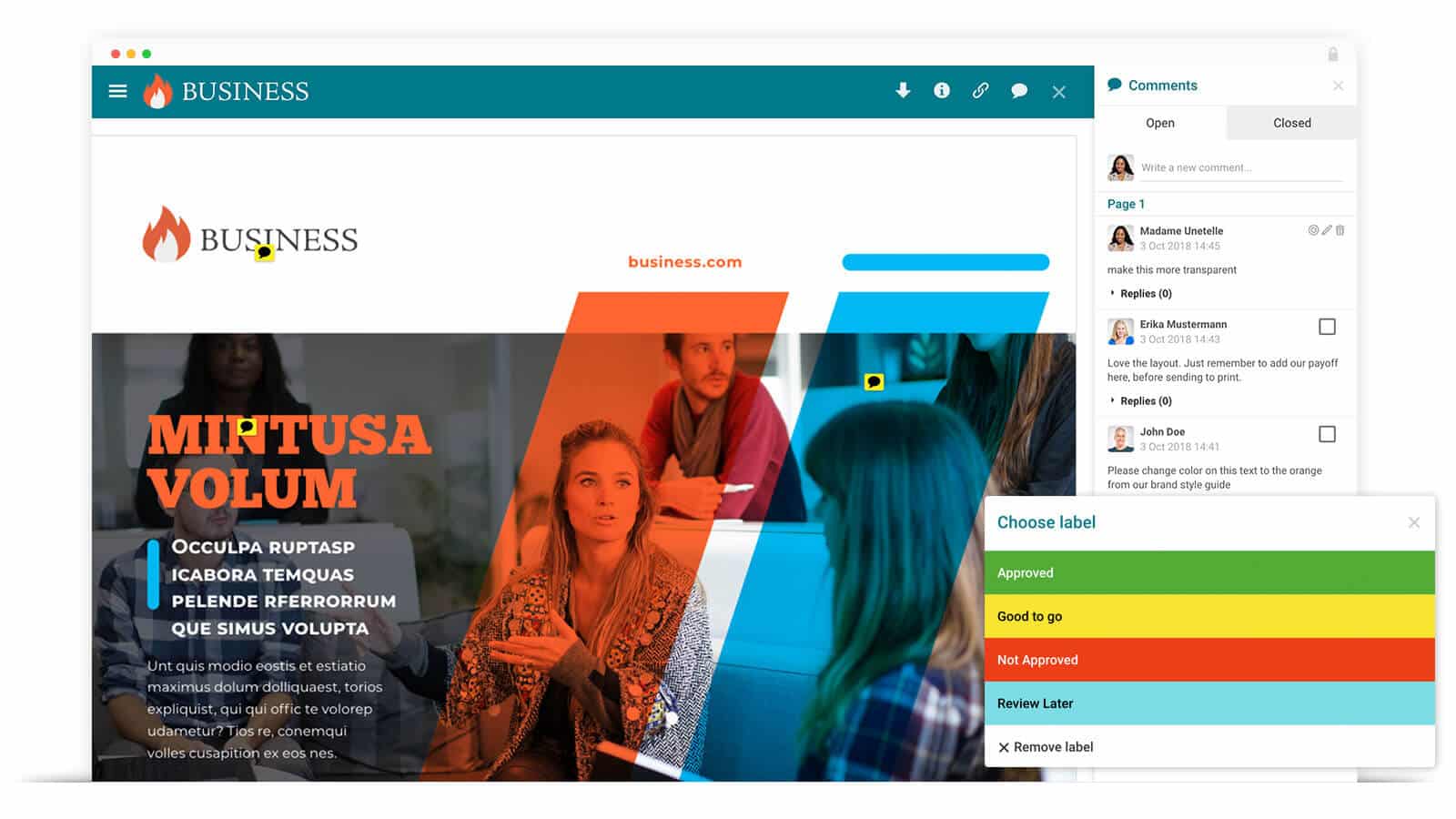
Online proofing tools can help you make collaboration with your clients more streamlined.
With online proofing and labeling, everyone can see when a particular asset has been approved. If there’s a problem and revisions are needed, you can use labels to quickly draw attention. Once the asset is approved, your team will know they can use it to move projects (e.g. an ad campaign) forward. If something’s resulting in a bottleneck, say an unapproved logo is preventing a new mail flyer from going to print, increased visibility will help you address the issue.
DAM solutions also help ensure version control. You might have multiple versions of a logo or other asset floating around and this increases the risk that the wrong version could end up being used online, in print, or anywhere else. Imagine if you print up 10,000 brochures only to realize you used an outdated logo.
With a DAM system, you can ensure that any employee knows where to find the most recent and approved copy of a logo or other asset. This helps ensure that everyone stays on the same page and increases brand consistency.
Offers Safety and Security
Some DAM solutions also offer better file security, including from external threats and internal mistakes. Many DAM options use secured file transfer technology and secured servers, for example. With syncing software, such as Dropbox, if an employee deletes a file on their computer, they might accidentally delete it on everyone else’s computer. With the right marketing DAM systems, however, a user would only delete the file locally on their computer, not everyone else’s.
Between increased communication, coordination, and brand consistency, DAM solutions offer a lot of benefits for teams big and small. And as remote work becomes more common, all of the above may become more necessary.
Remote Teamwork Tool
Remote work is the dream… for some. For others, it’s a bit of a pain. It’s often easier to coordinate a team when everyone is in the same building. Need something from a colleague? Forget email, just take a quick stroll down the hallway.
Yet remote work has been growing as a popular alternative, especially in the marketing industry where many, if not most, tasks are performed on a computer. And as the COVID-19 pandemic rages, many businesses have had to shut their offices down to protect employees.
A DAM solution is an excellent tool for teams, including remote teams. And while COVID-19 vaccines are hitting the market, offering some light at the end of the pandemic tunnel, remote work is likely here to stay. Many companies now realize they can downsize office space and thus cut overhead costs while maintaining or even improving productivity via remote work. Employees, meanwhile, are enjoying newfound freedom, flexibility, and comfort.
Organizing remote teams, however, can be a serious challenge. Getting everyone online for a simple Zoom call is quite the hassle. Coordinating teams to deliver complex products and services? The challenges and setbacks can quickly snowball and effectively managing digital assets and files becomes all the more important.
If you don’t effectively coordinate your team, including remote workers and other stakeholders, productivity could plummet, employees may disengage, you could lose clients, and various other problems may arise. Yet with a DAM system, remote workers can share and access digital assets no matter where they are.
Further, some DAM solutions also offer a digital trail. You will see who made comments when, who approved what, who uploaded or deleted any given file, and other details. This activity log makes it easier for you to go back in time to understand how events and work processes unfolded.
No Need for Training with Intuitive User Interfaces
The most intuitive DAM systems offer tools and a user interface that’s no more difficult to use than the native file systems on your computer. This means contractors, new team members, and everyone else can quickly get to work, no extensive training needed.
This is especially important for remote teams. Onboarding is difficult enough in-person. Remote onboarding can be a nightmare, especially if you use complicated tools that require a lot of training.
Of course, when it comes time to add new staff to the office, you’ll appreciate and benefit from easier onboarding. Work is simpler when everyone can find what they need, when they need without having to ask the IT department or their supervisor.
Allows Self-Service for Clients
What’s more, the right DAM system enables easy self-service. Instead of fielding emails from clients asking for this graphic or that photo, you can provide them a link to their folder within your DAM. This way, they can log on any time and access the files they need. Good DAM solutions offer granular control as well, so clients and other stakeholders can access only the folders you specify.
Build Brand Strength with DAM White Labeling
If you work in marketing, you probably already know just how important your brand is. Brand consistency is vital whether you’re a large company or a small firm. A strong brand will leave a good impression on potential customers, partners, and future employees. The right brand builds trust and conveys competency while also attracting your target audience.
Unfortunately, a lot of common tools for remote work and sharing don’t allow you to put your company’s brand first. If you sign up for a basic Dropbox account, for example, you can store files online and easily share them. However, when you share, Dropbox’s brand is front and center. And who can blame them? You’re using Dropbox’s software solution, after all.
Yet at the same time, your team and especially your clients may question your professionalism if you’re using a bunch of consumer-grade products. Want to make a good impression? Use a white labeled digital asset management system. Put your logos and the like right on the DAM interface, so that it’s branded as your tool and your platform.
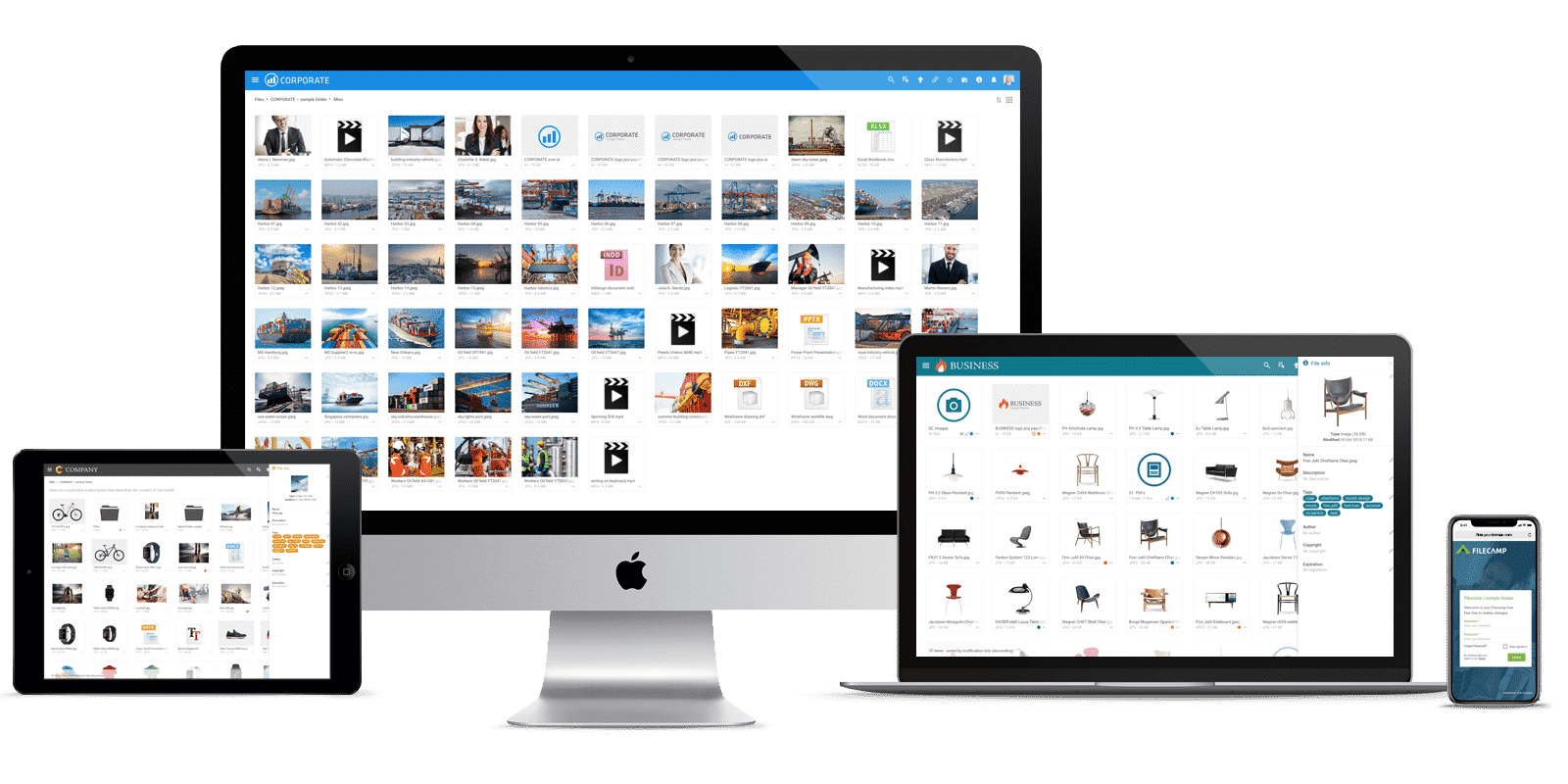
Most DAM systems allow custom branding so you can maintain brand consistency when sharing files and collaborating with your clients.
When a client logs in to look at the white paper you wrote or the new sales landing page you created, they’ll see your brand, not Dropbox or another solution. This delivers a more professional look and feel.
Some solutions also allow you to use your client’s branding to create a branded folder for them. This adds a more personal feel and helps show your attention to detail.
You can even charge your client’s a monthly fee to keep their assets stored and accessible online. This provides you with recurring revenue and makes access easy for your clients. A wedding photographer, for example, might upload wedding photos, then charge $5 a month for extended online portfolio hosting after the first month.
The point is, with DAM solutions, opportunities abound.
Selecting the Right DAM System for Your Business
Convinced you should add a digital asset management solution to your toolbox? If so, you’ll find plenty of options. Some of the most well-established marketing-oriented DAM systems cost hundreds or even thousands of dollars per month, putting them well out of the reach of many freelancers and small teams. Meanwhile, some consumer-grade DAM solutions lack key features.
Plenty of DAM options fall between these two extremes, starting at $30 or less per month while still offering plenty of professional tools and features. However, starting prices don’t always convey the full cost. Many DAM systems charge per user, so if you already have a team or believe your team will expand in the future, keep added user fees in mind as costs can quickly rise. A few DAM solutions charge a flat monthly rate with unlimited users, which keeps costs low even as your team expands.
Beyond that, you should consider your branding and other needs. If you’re looking to impress large corporate clients, for example, a white labeled DAM solution may offer a more professional look and feel. On the other hand, if you’re managing a number of projects for established clients and not focused on growth, white labeling may not currently be necessary, especially at added cost.
There are many other factors to consider as well. It’s smart to jot down your needs and identify bottlenecks and other hang-ups in your current work processes. When selecting a DAM solution, it’s a good idea to select a solution that can ease bottlenecks and also grow alongside your company while keeping costs low. Also consider user support, how intuitive the user interface is, how much storage is provided, and other key factors.
Either way, if you’re in the market for a DAM system, you’ll likely find one that suits your needs and fits your budget.
_
About the author: Jesper Faurby is co-founder at Filecamp – a digital asset management solution for freelancers and entrepreneurs. Before starting Filecamp, Jesper used to be a graphic design freelancer in Copenhagen, Denmark.
The post Why & How To Manage Your Digital Assets: Digital Asset Management For Marketers first appeared on JUST™ Creative.
No comments:
Post a Comment